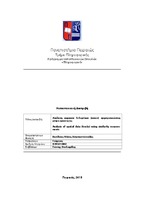Ανάλυση χωρικών δεδομένων (ιχνών) χρησιμοποιώντας μέτρα ομοιότητας
Analysis of spatial data (tracks) using similarity measurements

View/
Keywords
Spatial data management ; Χωρικά δεδομέναAbstract
The comprehension of phenomena related to movement - not only of people and vehicles
but also of animals and other moving objects - has always been a key issue in many areas
of scientific investigation and social analysis. The spread of tracking technology, not only
provide us with a considerable tracking data source that enables us to study the habits of
people, but also introduces open research challenges with respect to the exploitation of
such wealth of data.
In the last years there is a growing popularity over the eye tracking data. Eye tracking
is the recording of the eye movements and is the process of measuring either the point of
gaze (where one is looking) or the motion of an eye relative to the head. The recording and
the analysis of eye movements constitute an effective method for the exploration of several
aspects related to human vision,perception and visual behaviour. It provides objective
and quantitative evidences towards the examination of visual attention and a way to examine
processes related to visual search, visual perception and cognitive process, which occurs
during the observation of a stimulus.
Tracking data have similar structure with eye tracking data. Τhe main difference is that
tracking data are defined by coordinates (in geographical space) and maybe some additional
attributes that may also be present and eye tracking data are defined by gaze coordinates on
a screen. The structural similarity suggests that both classes of data may be analysed using
the same methods.
When working with eye tracking data, the determination of some measurement of similarity
between many subjects gaze is desirable. Object similarity or object dissimilarity or
object matching or shape matching is the decision of the resemblance (similarity) between
two objects. The object similarity functions of tracking data can be used in eye tracking data
for extracting similarities between the gazes of two subjects. However, not all methods may
be relevant since the movement properties are not the same for eye movements and for
road or sea traffic, human mobility, or animal migration.
In this thesis we examine how the object similarity functions can be applied to eye tracking
data and a toolkit is developed for this purpose. Also a case study, that use the software
is presented and the results of this case study are shown.


